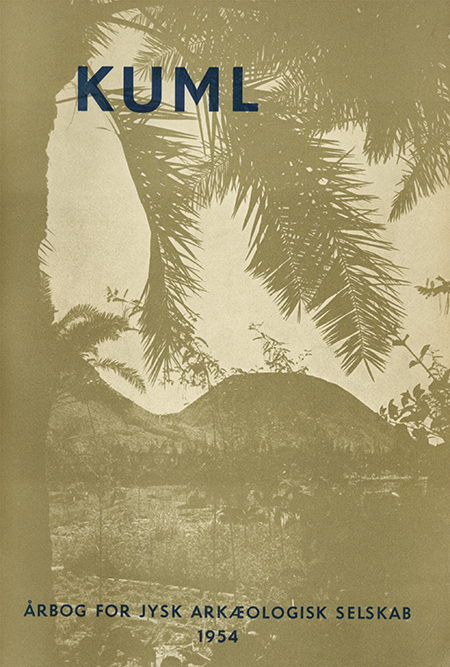Striber på kryds og tværs
DOI:
https://doi.org/10.7146/kuml.v4i4.97142Keywords:
Plough furrows, Pløje spor, Aldrupgaarde, Aldrupgård, Ard sporAbstract
Criss-cross Furrows
Plough Furrows under a Stone Age-barrow in Jutland.
At Aldrupgaarde (Hvorslev parish, Viborg county, North Central Jutland) a completely razed Single-Grave tumulus was investigated in the spring of 1954. The excavation revealed an almost undisturbed grave, located upon the original ground surface. It was surrounded by a rectangular framing of stones, inside which were found the remains of a plank coffin which had been supported on each of the longer sides by two posts (Fig. 2).
The post holes appeared as concentric circles with a dark core, which presumably represents the decayed post, while the outer rings are the traces of a preliminary boring and of iron deposition respectively. The full diameter of the post holes is 20-25 cms., while the depth of the two southern holes is 0.64 and 0.48 meters respectively (Fig. 3).
The body lay directly upon the original ground surface on its right side with its head to the west. The skeleton was completely decayed but showed as dark bands (Fig. 2).
The furnishings of the grave (Fig. 4) consisted of a thick-butted axe, 16.4 ems. long, slightly curved longitudinally and of a typical Single-Grave pattern, and of a little fragment of a flint blade. The axe lay before the head of the deceased with the blade towards the face. The flint blade lay by the western end of the grave.
The dating of the grave to the Late Under-Grave or Early Ground-Grave phase is based on the type of grave, the position of the body and the burial furniture 1-7).
The most important result of the excavation was the discovery of a network of plough furrows beneath the grave and over the whole excavated area (Fig. 1). In the light subsoil, consisting of sand with patches of clay, the plough furrows stood out as a criss-cross of stripes. The width of the furrows varied between 3 and 10 cms., and the average distance between them was 30 cms. The directions of ploughing were E-W and NNE-SSW.
A section through a series of furrows (Fig. 5) shows that the maximum depth in the sub soil which was reached by the ard was 9 cms., and that the cross-section of the furrows has the shape of an oblique angle with one side steep and vertical and the other curved and gently sloping.
The furrows are dated by the grave which gives a terminus ante quem for the ploughing. They therefore provide the earliest definite evidence for the use of the plough in Europe. It is moreover believed that the furrows belong to the Single-Grave culture. This culture is represented on the site by culture remains in the body of the mound and by three further Single-Grave tumuli in addition to the one excavated. In the vicinity the Single-Grave culture was dominant since the Under-Grave phase. From the same phase of development of the Single-Grave culture come the earliest impressions of corn in pottery yet demonstrated 8). In Europe prehistoric fields have not yet been traced further back than to Late Neolithic times. In Denmark the presence of fields in this period has been seen in the heaps of stones collected from the fields9), and in England in the form of irregular field systems surrounded by baulks10), while in Holland and. in Norway Late-Neolithic plough furrows have been found 11).
In agreement with P. V. Glob's hypothesis 12) the presence of "shoe-last wedges" is believed to demonstrate that agriculture and the plough were introduced simultaneously in the area of Europe dominated by the Danube cultures. Discoveries of shoe-last wedges in Denmark is taken as an indication that the same situation may have operated in Denmark 14a), though the Danish shoe-last wedges may have been first introduced as late as the Middle Neolithic Period 14b)
The oblique angle of the cross-sections of the Aldrup furrows agrees with the cross-sections of the Early Bronze Age furrows from Sevel16), with the marks of wear on the shoe-last wedges and with the Iron-Age ploughshares found in peatbogs 17). As a result of these correlations it is believed that the furrows were made by a crook-ard which was held somewhat obliquely during ploughing.
The discovery in recent years of plough furrows under Bronze-Age tumuli has shown that the cultivation of heavy clay soils began as early as the Early Bronze Age, with the ard as the ploughing implement20). The Aldrup furrows suggest that heavy soils may have been cultivated as early as Middle Neolithic times, as the subsoil changes from sand to clay only a few yards from the tumulus.
P. Kjærum
Downloads
Published
How to Cite
Issue
Section
License
Fra og med årgang 2022 er artikler udgivet i Kuml med en licens fra Creative Commons (CC BY-NC-SA 4.0).
Alle tidligere årgange af tidsskriftet er ikke udgivet med en licens fra Creative Commons.


